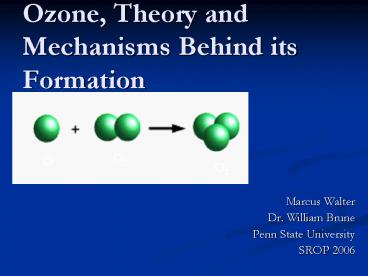Ozone, Theory and Mechanisms Behind its Formation
1 / 18
Title:
Ozone, Theory and Mechanisms Behind its Formation
Description:
Forms in the lowest part of the atmosphere, Troposphere and blocks UV rays from ... A. R. Metcalf, A chamber study of photochemical oxidation processes in the ... –
Number of Views:140
Avg rating:3.0/5.0
Title: Ozone, Theory and Mechanisms Behind its Formation
1
Ozone, Theory and Mechanisms Behind its Formation
O2
O
O3
- Marcus Walter
- Dr. William Brune
- Penn State University
- SROP 2006
2
Introduction
- What is Ozone
- Reactive gas, a part of the Earth atmosphere
- Two Classifications
- Good Ozone
- Forms in the stratosphere and blocks UV rays from
the sun - Bad Ozone
- Forms in the lowest part of the atmosphere,
Troposphere and blocks UV rays from the sun - Harmful to Humans, Crops, and other vegetation
3
- Scientist have a basic theory for how bad ozone
forms - Nitric Oxide (NO) from combustion volatile
organic compounds (VOCs) sunlight lead to the
production of ozone - There is a Problem
- Using this theory, the predicted and actual
amounts of atmospheric ozone dont agree - If scientists are able to learn all the
mechanisms that produce ozone in the troposphere,
possibly regulations can be put in place that
will most effectively control the formation of
ozone and other secondary pollutants
4
Research
- Study the theory of Ozone formation in the
troposphere - Want to answer two main questions
- Is the theory on Ozone formation correct?
- Are there other mechanisms that form ozone?
- Will involve building an atmospheric chamber to
perform controlled experiments - Chamber will be used to verify the basic theory
of ozone formation - The chamber will simulate real atmospheric
conditions - Once the theory is verified, more complex systems
with more reactants will be studied to search for
unknown mechanisms that form ozone
5
Theory of Ozone Balance
- Formed by the combo of atomic Oxygen and
Molecular Oxygen - (1) O O2 M? O3 M
- M is a third body that absorbs energy from the
reaction - Only Significant source of O in the troposphere
is created from the photodissociation of NO2 - (2) NO2 hv ? NO O
- hv is the ultraviolet energy from the sun
- This NO formed reacts with O3
- (3) NO O3 ? O2 NO2
6
Photostationary Steady State (PSS)
- With only reactions 1, 2, and 3, PSS occurs
- No change in concentration of O3, NO2, NO
- Reactions cause N and O to cycle between the
gases but concentrations stay the same. - In remote regions, PSS is valid in general
- In industrial areas, PSS gets a little out of
balance
7
Ozone Formation
- Reaction path that convert NO to NO2 without
consuming O3 allows for O3 formation - Path is created by hydrocarbons, specifically
peroxy radicals - Peroxy radicals are organic molecules chemically
bonded to O2 (ex. CH3O2) - Here are the reactions
- (4) RO2 NO ? NO2 RO
- (5) NO2 hv ? NO O
- (6) O O2 M ? O3 M
- _________________________
- (7) RO2 O2 hv ? RO O3
- (R CH3, C2H5, C3H7, )
- Other set of reactions the lead to ozone
formation - (8) OH RH ? RO2 HO2
- (9) OH CO O2 ? HO2 CO2
- (10) HO2 NO ? OH NO2
- NO2 then reacts and eventually forms ozone
8
Environmental Chamber
- Used to simulate atmospheric conditions
- Made of various materials
- Black light surround the chamber
- Simple reaction will occur within the chamber to
form ozone - More complex reactions will be included to find
unknown chemical reactions that form ozone
9
(No Transcript)
10
(No Transcript)
11
(No Transcript)
12
PSS Experiment
- Chamber was filled with NO2 mixed with purified
air (zero air) - Allowed to come to a constant concentration in
parts per billion - UV lights were turned on, start of the breakdown
of NO2 which eventually forms ozone, through
reaction 1, 2, and 3 - Chamber is allowed to reach PSS
13
(No Transcript)
14
(No Transcript)
15
Results
- Was not able to verify basic theory
- Caused by limited supplies
- Only able to do one run
- With the one run
- Data did not match theory
- Probably due to a number of things
- Impurities in zero air which entered the chamber
- O3 reacts with impurity thus lower O3
concentration - Gas escaping out the chamber
- O3 reacting with impurities on the walls of
chamber
16
Conclusion
- Results didnt match theory
- Next time do more runs
- Make sure the zero air is definitely purified air
- Increase thickness of the PFA to make sure no gas
escapes out of the chamber
17
References
- Seinfeld, John H. Urban Air Pollution State of
the Science. Science, Volume 243, Issue 4892, pp.
745-752, 1989 - Wallace, John M., Peter Hobbs. Atmospheric
Science, an Introductory Survey, Second Edition,
Academic Press 2006 - J. Timmerman, private communication, 2006
- A. R. Metcalf, A chamber study of photochemical
oxidation processes in the atmosphere, M.S.
Thesis, Pennsylvania State University, 2005 - www.epa.gov
- Dr. William Brune, Meteorology Professor, Penn
State University - Dr. Verlinde, Meteorology Professor, Penn State
University - William Ryan, Meteorology Professor, Penn State
University
18
Thanks
- Dr. William Brune, Meteorology Professor, Penn
State University - Amber Ortega, Undergraduate Meteorology Student,
Penn State University - Xingron Ren, Postdoctoral Student, Penn State
University































